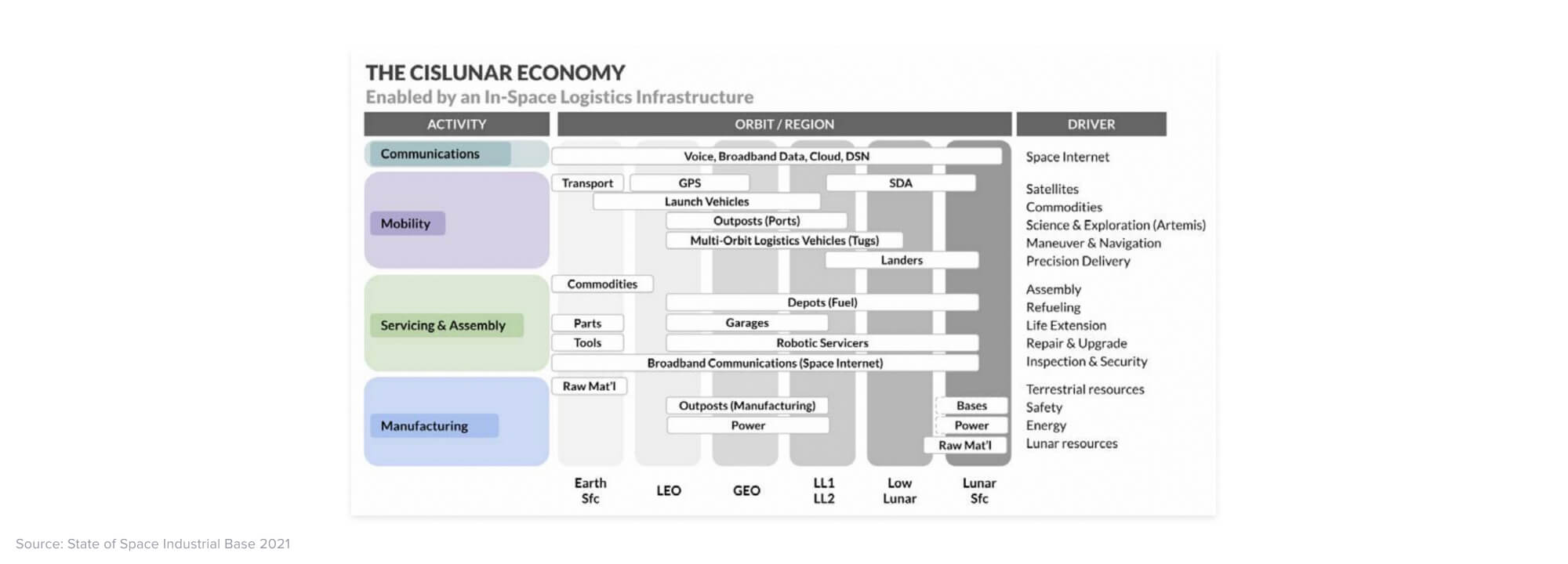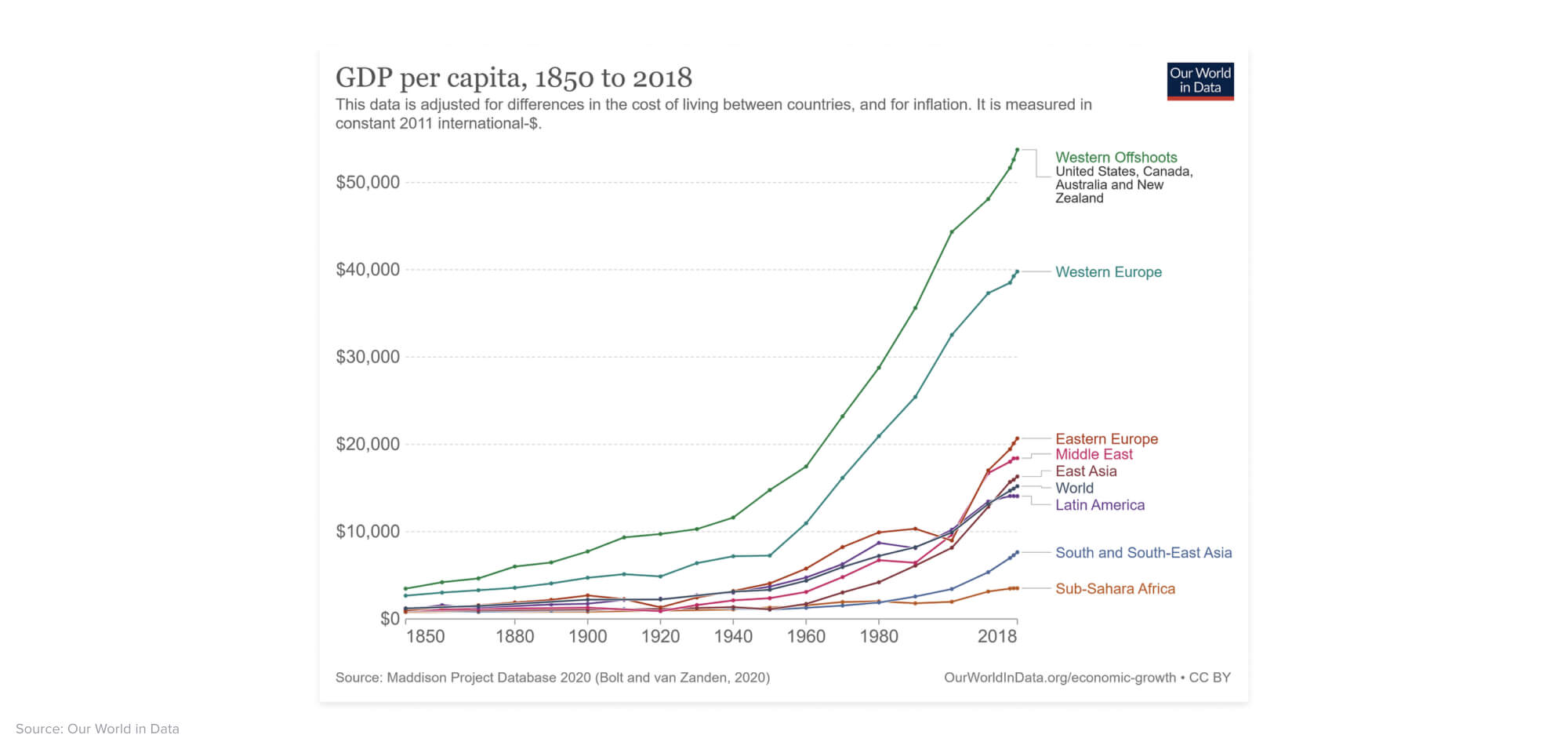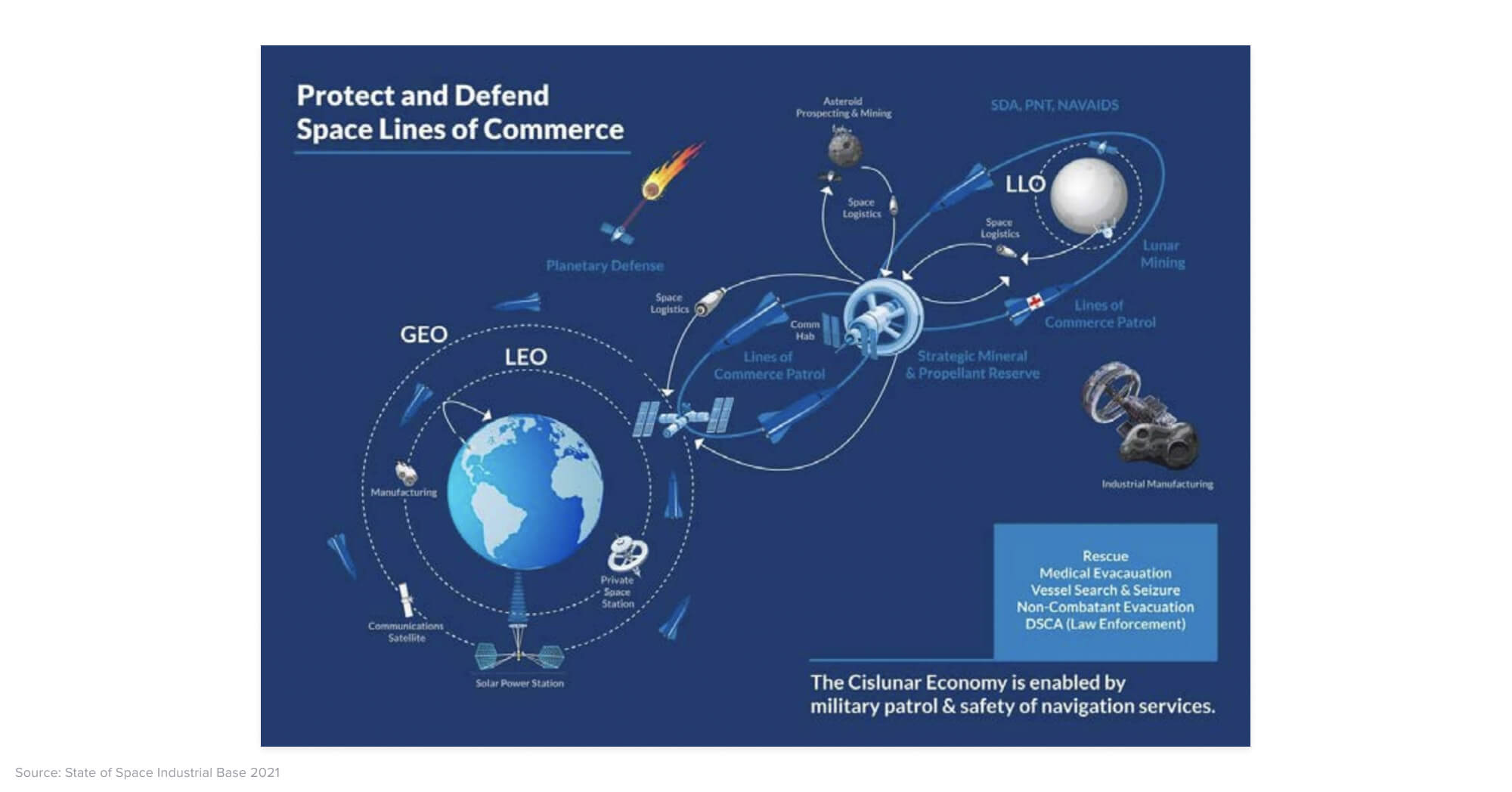For some of us, the echo of the Space Race remains a catalyst for our daily pursuits. But a changing world demands more, and we stand today at the dawn of a new age. Sixty years later, we are in the early innings of the Space Age, and control over this new arena will be the driver of economic growth and measuring stick of power for the coming centuries, perhaps millennia.
To grasp the weight of this, we must understand the source of America’s strength today, and the potential that a new frontier holds. Through looking at the past, we can also materialize a framework for space exploration and development — one that is not just a science-fiction future, but an increasingly tangible reality.
TABLE OF CONTENTS
Reaching new frontiers
TABLE OF CONTENTS
The past presents an outline for what’s ahead, and space conquest is no different. We’ve developed a new world relatively recently — America — and the final frontier will likely follow a similar pattern: Four critical steps to build a permanent foothold.
1. Breaking into new worlds
Breaking into a new world is incredibly dangerous and expensive, and often necessitates a multitude of discoveries along the way, simply for survival. It’s because of this inherent risk that these endeavors are so often initially supported by governments, like how the Spanish monarchy sponsored Christopher Columbus’ voyages.
As with the early explorers of America, the first treks into space were funded by centralized powers. For America, beating the Russians to the moon was perhaps as important to winning the ideological battle of the Cold War as New World exploration was to European power struggles. This was the Columbus moment. Through immense effort, landing on the moon broke open a new world.
2. Recurring voyages
However, it’s not enough to just break into a new world; if that was the case we’d recognize Leif Erikson as the discoverer of America instead of Christoper Columbus. Development is what matters.
Soon after the charting of America, long-distance fishing fleets were dispatched to Newfoundland and the eastern seaboard. In coming years, the search for the Northwest passage would beckon fur trappers to the Gulf of St. Lawrence, conducting some of the earliest trading between Europeans and the native peoples. Critically, though, these were temporary missions, not permanent settlements. Europeans would venture to this new world, work for a time, and then return to the old.
However, these efforts served to commodify the journey itself — reducing what was once an unknown destination to a seasonal trek.
The proliferation of commercial space hints at a similar pattern. Today, the vast majority of the space economy is sustained by satellites located in low Earth orbit (LEO). For the sake of analogy, let’s call this the coastline of space. Many of these satellites are, by design, temporary, serving a lucrative purpose for a period of time before de-orbiting (returning to Earth). While getting into space once was once a task reserved for governments, this new space economy has demanded greater launch capacity. Led by SpaceX, the launch industry is increasingly becoming commodified.
3. Outposts and infrastructure
Reducing the risk of getting to your destination allows you to set greater ambitions once you arrive. For adventurous Europeans, this meant long-term outposts. To this end, there are two great, contrasting examples of early footholds: Roanoke and Jamestown.
Backed by Sir Walter Raleigh, Roanoke was the first English attempt at settlement in America, located on the coast of modern North Carolina. In the explorers’ terms, this venture sought God, glory, and gold. Practically, that meant they aimed to convert the natives, interrupt Spanish shipping, and harvest precious resources. However, when Roanoke failed at these objectives, it relied on pilgrimages to London to seek additional financing for more supplies. Roanoke limped on for a time before tragedy struck, and its inhabitants mysteriously disappeared before the next shipment arrived.
In contrast, Jamestown succeeded where Roanoke failed. After a hurricane shipwrecked him in Bermuda, John Rolfe came across a sweeter strain of tobacco, which he brought to Jamestown. This cash crop grew only in specific climates, and was heavily sought after in Europe. Through tobacco cultivation, Jamestown evolved from a struggling colony into a profitable venture.
Building footholds in new worlds requires immense capital, and establishing a legitimate enterprise serving old-world customers is a great way to get it. Jamestown leveraged a competitive advantage in the new world to sell goods to the old — not too unlike the modern space economy that’s predominately comprised of earth observation, telecom, and GPS satellites serving terrestrial customers. Beyond this, there are other goods that can only be produced in space — processing ZBLAN optic fiber, printing biological components, conducting certain scientific research, manufacturing advanced materials, and even zero-gravity tourism — and therefore present the next obvious step.
4. Permanent settlement and services
There comes a point in time when a new world’s economy becomes mature enough to support a variety of products and services on its own. For America, settlements acted as both a crucible for innovation, and as a gateway into the interior of the continent.
In time, American strength stretched from sea to sea; rooted in the laws of an island nation (England), yet with the geography and resources of a continent. A landmass composed of fertile soil and the most navigable inland waterways, and surrounded by a desert, a tundra, and two oceans on either side. This combination birthed a liberal democracy whose chief exports are a stable political economy, culture, and power projection. With their house in order, the United States took to the seas and became the greatest naval power in history.
It appears we are nearing a similar development inflection point with space, and it’s now that the last frontier truly begins to open. At this precipice of conquest, it’s important to look at the big picture — the “space industrial base.”
A supply chain, in space
The term space industrial base was coined by NASA, the U.S. Space Force, and the U.S. Air Force. Simply, the space industrial base is made up of a supply chain from Earth, through cislunar orbit, to the moon, and beyond. Like the seas before it, this is the future substrate of commerce that connects civilization.
The idea of trade in space, let alone a supply chain, might seem far-fetched, but it begins to make sense when we recognize that American colonization started much the same way. There are many ways to look at space development thus far (e.g. technological breakthroughs or capital invested), but the most compelling lens is much simpler. Let’s look at just how far industry has ventured into space.
This chart details specific products and services that make up the space economy — present and future. We move from left to right; from Earth, through higher-energy orbits, and then reach the lunar surface. Of course, this is by no means an all-inclusive picture of what it will take to build out a cislunar economy, but it does help illustrate an important point: These technologies become economically viable sequentially, and require the support of upstream processes.
For example, a satellite company like Astranis might partner with Apex Spacecraft to streamline costs and accelerate development of their satellite bus. Together, these companies function because SpaceX has de-risked getting to space, an incredibly difficult engineering feat in its own right. Moving farther upstream, SpaceX requires parts to build its rockets, leaning on a fractured industry of independent metal shops — a problem that Hadrian is solving. But then Hadrian is reliant on raw materials, inputs that are becoming increasingly competitive. Additionally, a skilled workforce is needed to operate advanced tooling throughout this supply chain, perhaps powered by a company like UpSmith or Workrise. Undoubtedly, the space industrial base begins here on Earth.
Space development is still largely in low Earth orbit (LEO), but glimpses of more tangible footholds are emerging. The proliferation of satellites demands an ecosystem of space services, notably “tugs” to maneuver in and through various orbits. Moreover, a number of commercial space stations are in active development, and some companies are seeking to begin zero-gravity manufacturing operations. Once firmly established, these outposts will demand water, oxygen, and a variety of other materials depending on their use case.
And this is when things start to get really interesting.
This image may bleed into science fiction, but that doesn’t mean it’s impossible. Consider that Jamestown was established over 100 years after the discovery of America. These things happen slowly, then suddenly.
The most difficult part about space is getting there — Earth is a giant gravity well, which means building mega structures using terrestrial materials is cost prohibitive. But these materials don’t necessarily need to come from Earth. Having a resilient foothold in a new world makes harvesting its resources much easier, each leg of the effort de-risked until you must only worry about extraction itself. This would make possible entirely new creations and limitless sources of energy, both for space and on Earth. Imagine all heavy industry in orbit, and a garden planet below.
Past efforts at space mining have failed, but recent developments are putting the necessary pieces in place to make it far more achievable. The space industrial base presents a framework for celestial development, and helps set a pragmatic outline for science and industry. The rewards here are literally incalculable, and represent an impending gold rush. This is how civilization extends into the stars.
A space partnership
We’ve been careful so far to highlight the achievements of the private sector, but American space development is certainly a public-private partnership that extends through generations. An authoritarian power, the Soviet Union, was the first to reach space. However, leveraging a network of American institutions, defense primes, and the nascent technology industry, the Apollo program beat the Soviets to the moon.
In the ensuing decades, the United States has continued to define American space policy as a public-private partnership. Government provides the structure (and, often, fundamental research and funding opportunities) and the private sector manifests it, leaving a functioning ecosystem in its wake. Today, America faces another challenge from an authoritarian regime in China, but American space policy remains focused on unleashing the might of market forces.
This is critically important. The dawn of commercial space has ushered in an era of heightened priority around extraterrestrial resources. In 2015, President Obama signed the SPACE Act that, among other objectives, allows private companies to profit off “space resources and minerals”. However, this was more of an addendum to the Outer Space Treaty, a 1967 agreement forbidding claims of sovereignty over celestial bodies. Organizations demanded further clarity.
This came in 2020 when President Trump announced the Artemis Accords, which dictate that any settlement on a rocky body requires assurances that resources can be secured without provocation. Grounded in the Outer Space Treaty, the Artemis Accords, signed by a majority of our allies, outlined safety zones of “no interference”, interpreting terms from 1967 to better promote off-world resource utilization. Space is now open for business.
A keystone of space policy in the coming years is the Artemis Project, which aims to develop the moon as a launching pad for deep space ambitions. To accomplish this, NASA has awarded contracts to a number of private companies across launch services, spacecraft manufacturing, lander development, mining tools, and many other technologies. NASA is also designing its own capabilities, though, admittedly, it is increasingly less efficient than the private sector.
In 2020, NASA selected winners for a contract to collect lunar soil. NASA does not need lunar soil, but in creating this market, the private sector develops the capabilities to do it. It’s a minimal investment to get the future off the ground, and exemplifies the path for American space development.
Space Race 2.0
The recent acceleration of space policy stems from growing competition. As of 2021, China has beaten the United States in the number of successful launches in a calendar year. And although they still chase the United States in tonnage to orbit, these iterations narrow the technological gap. Additionally, recent missions to the moon and Mars demonstrate Chinese ambitions for discovery and settlement of deep space. At this trajectory, the U.S. Space Force believes China will exceed the United States by 2045, if not earlier.
This matters: Conflict already looms as both the United States and China aim for the same lunar settlement site, home to a unique composition of resource deposits. With the assistance of Russia, China’s lunar base is stated to be completed by 2027 – eight years ahead of the original plan. In terms of space development, these are startlingly fast timelines.
For the United States and its allies, this is very concerning. When it comes to trade, space is essentially a much larger version of Earth’s oceans. And in our modern world of global markets, those who control the substrate of trade wield enormous power. America’s naval fleet — which in terms of sheer tonnage is larger than the next 13 combined — has reinforced the greatest single period of prosperity in the history of mankind. Poor and destitute nations, without the ability to finance development and trade goods on their own, were given secure access to global consumer markets, effectively underwritten by the United States’ Navy. Today, 90% of the goods we use once sat on a container ship, often departing from ports thousands of miles away from their destination.
In particular, this is how China rose to prominence, becoming an industrial behemoth and lifting hundreds of millions of people out of poverty without a “blue-water” navy of its own, as was historically necessary for a trading power.
Dominion over the arteries of nations bequeaths special privileges and rule-making abilities at the international level. For example, convincing nations to ally with the United States and western institutions instead of the Soviet Union, in return for security and access to our markets. This was a good deal for many, and laid the foundation for the 21st century. How a space-centric global market evolves depends heavily on who controls the trade routes.
We are already witnessing the importance of space today. It is the ultimate height advantage, and modern conflicts are decided by capabilities in this domain. Take Ukraine for example, where satellites provide near real-time intelligence. Future conflicts will be determined by advanced targeting capabilities, point-to-point power projection, and a robust network of autonomous systems — all of which necessitate assets in space.
The new sea
Space is far too important to simply cede development to others. Control of this new sea and development of the space industrial base are paramount toward the continued strength of the United States, and the prolonging of a world of free markets and liberal democracies.
At the end of the day, this seismic effort requires the might of a strong, skillful, and, most of all, determined population. As a nation, we can accomplish this task ahead of us. That one small step might spawn another, then cast us forward into a stride — expanding our civilization into the pantheon of the heavens.
A new age is upon us. Climb aboard.
If you’re helping build the Space Industrial Base, or just want to chat about it, send me a note: rmcentush at a16z dot com







